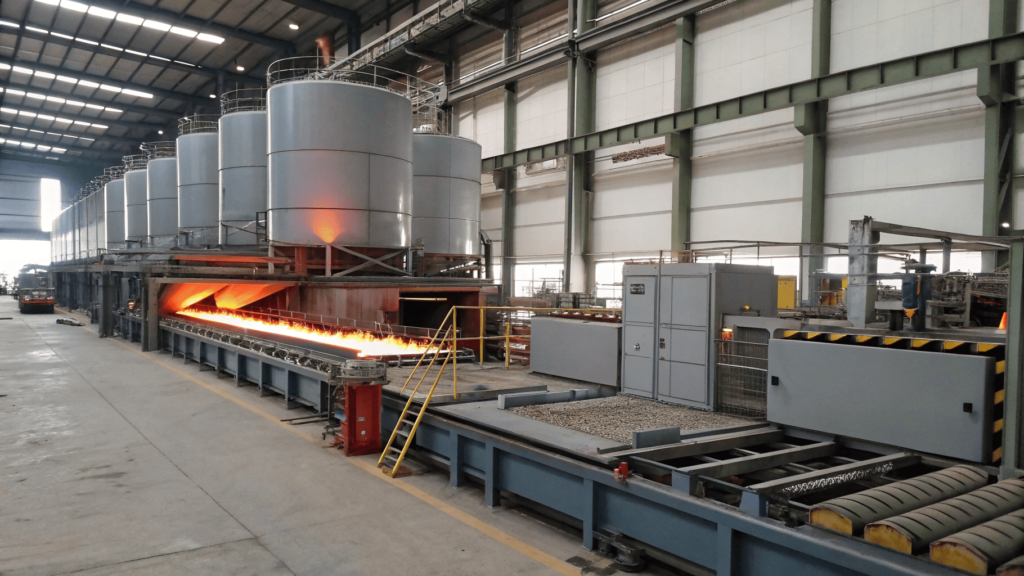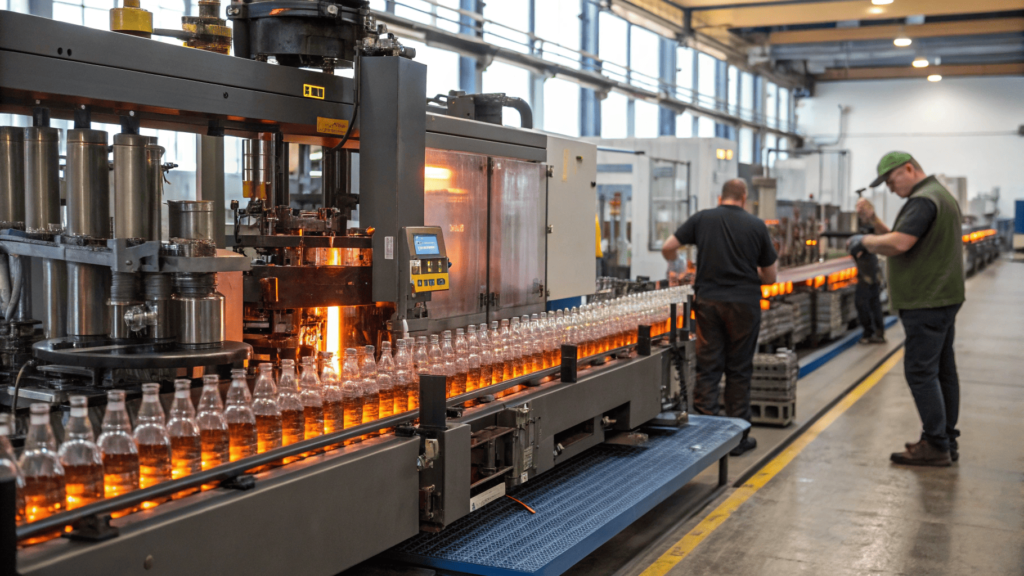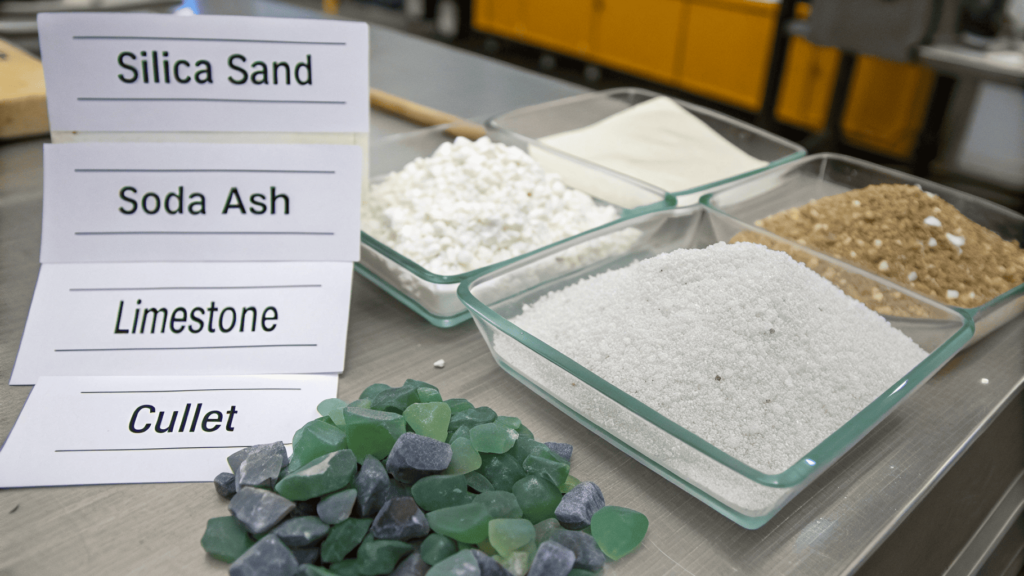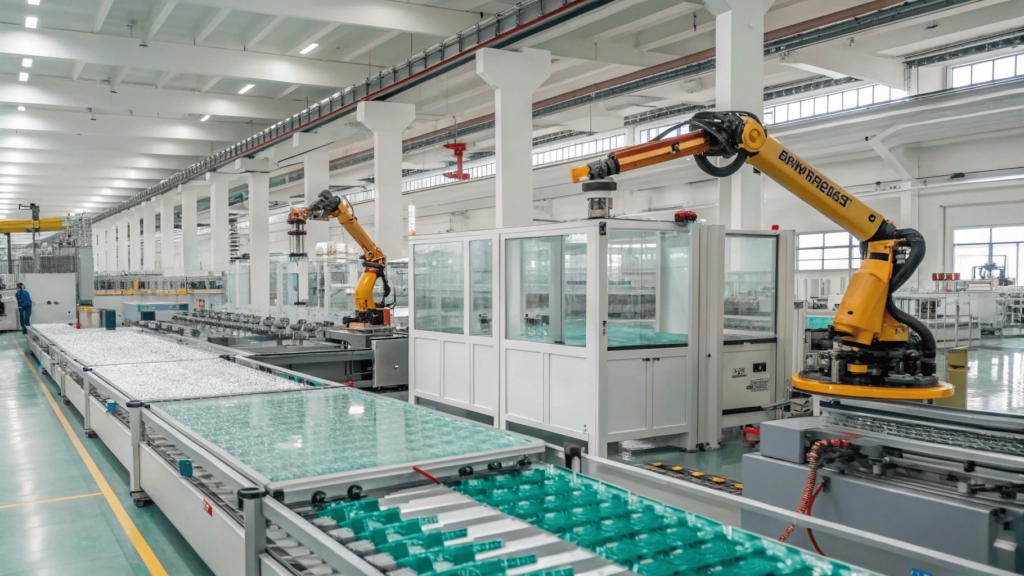Struggling to understand the complex machinery behind glass production? Concerned about outdated equipment impacting quality? We simplify the essential machines needed for modern glass making.
Making glass involves several key machines: batch plants for mixing raw materials, furnaces for melting, forming machines (like float lines or molds), annealing lehrs for controlled cooling, and cutting/finishing equipment. These ensure quality from start to finish.
Understanding the basic machinery is the first step. Many people I talk to are surprised by the complexity involved. But what specific equipment is essential for a modern production line? Let's explore the core components needed to turn raw materials into finished glass products, ensuring you have what you need for high-quality output.
What equipment do you need to make glass?
Setting up a glass production line seems daunting? Worried about missing crucial equipment? Here’s a breakdown of the essential machinery you absolutely need for successful operation.
Essential equipment includes a batch system (silos, scales, mixers), a melting furnace (gas or electric), forming equipment (float bath, rollers, molds), an annealing lehr for stress removal, and cutting/inspection systems for quality control. Each plays a vital role.
Let's dive deeper into the sequence and purpose of this equipment. As Managing Director at Glass Coat, I've seen how crucial understanding the entire process is, even when focusing on downstream steps like coating. A solid foundation in base glass production ensures better integration and final product quality.
Batch Plant Essentials
The process starts here, preparing the raw ingredients. Think of it as the kitchen of the glass plant.
- Silos: Large containers hold the primary raw materials: silica sand, soda ash, and limestone. Sometimes dolomite or feldspar are also used depending on the glass type. Proper storage prevents contamination and moisture issues.
- Scales: Precision is key. Automated scales weigh exact amounts of each material according to the specific glass recipe. Even small variations can affect the final glass properties.
- Mixers: The weighed materials, along with cullet (recycled glass), are thoroughly blended into a homogenous mixture called the 'batch'. Consistent mixing prevents streaks or cords in the final glass.
Melting Furnaces
The heart of the operation, where the batch transforms into molten glass.
- Types: Furnaces vary, including Regenerative (using waste heat to preheat combustion air for efficiency), Recuperative (similar but using a heat exchanger), or fully Electric (often for specialty glasses). The choice depends on scale, fuel cost, and environmental regulations.
- Temperature: These furnaces operate at extremely high temperatures, typically around 1500-1700°C (2700-3100°F), needed to melt the silica sand.
- Refractories: Special heat-resistant bricks line the furnace to withstand these temperatures and the corrosive nature of molten glass.
Forming and Annealing
This stage shapes the molten glass and makes it stable.
- Forming: For flat glass (like windows or screens), the float process is dominant. Molten glass flows onto a bath of molten tin, creating a perfectly flat surface and uniform thickness. For containers (bottles, jars), machines use molds with 'press-and-blow' or 'blow-and-blow' techniques.
- Annealing: Glass must be cooled slowly and uniformly in a long oven called an annealing lehr. This controlled cooling relieves internal stresses built up during forming. Without it, the glass would be brittle and break easily.
Cutting and Finishing
The final steps prepare the glass for use or further processing, like coating.
- Cutting: Automated tables with scoring wheels or lasers cut the continuous ribbon of flat glass or formed shapes into desired sizes.
- Finishing: Depending on the application, edges might be ground or polished.
- Inspection: Automated systems using cameras and lasers scan the glass for defects like bubbles, stones (unmelted particles), or stress lines.
While Glass Coat focuses on the advanced nano-coating lines applied after these stages, understanding this primary production equipment is vital. The quality of the base glass directly impacts the success of our coating processes.
Can glass be machine made?
Wondering if intricate glass items are purely handmade? Concerned about the scalability of glass production? Discover how machines revolutionized glass manufacturing, enabling mass production.
Yes, absolutely. Most glass produced today, especially flat glass (windows, screens) and container glass (bottles, jars), is made using highly automated machinery. This ensures consistency, speed, and cost-effectiveness vital for industrial scale.
The difference between handcrafted art glass and industrial glass production is vast. In my experience visiting numerous plants, the level of automation is often staggering. Let's explore how machines took over and what that means for the industry.
The Rise of Machine Production
Glassmaking was a manual craft for centuries. Then came key inventions.
- Historical Shift: Michael Owens' automatic bottle-making machine in the early 1900s was a game-changer for container glass. Later, the Pilkington float glass process, developed in the 1950s, revolutionized flat glass production. These innovations made large-scale, affordable glass possible.
- Benefits: Machines offer incredible advantages:
- Speed & Volume: Producing thousands of bottles per hour or vast ribbons of flat glass continuously.
- Uniformity: Consistent thickness, shape, and quality piece after piece.
- Cost Reduction: Lower labor costs per unit and less material waste.
- Safety: Reduced worker exposure to extreme heat and sharp materials.
Types of Machine-Made Glass
Different processes cater to different products.
- Flat Glass (Float Process): This is how nearly all architectural and automotive glass is made. Molten glass flows from the furnace onto a large, shallow bath of molten tin in a controlled atmosphere. Gravity pulls the glass flat, and surface tension ensures smooth surfaces. The ribbon then cools slowly as it moves across the tin and into the annealing lehr. Adjusting the flow rate and roller speeds controls the thickness.
- Container Glass (IS Machines): Individual Section (IS) machines dominate bottle and jar production. They use a combination of pressing, blowing, and vacuum forming within molds to shape 'gobs' of molten glass delivered from the furnace. These machines are complex marvels of timing and mechanics.
- Fiberglass: Molten glass is drawn through super-fine holes (bushings) to create thin filaments used for insulation or reinforcement materials.
Limitations and Niche for Handcrafting
Despite automation's dominance, handcrafting still exists.
- Art Glass: Highly complex shapes, unique colors, or embedded designs are often best achieved by skilled artisans.
- Small Runs: For very limited production of specialty items, the cost of setting up automated machinery might not be justified.
- Prototypes: Sometimes initial designs are explored manually before scaling up.
For Glass Coat, our coating equipment is specifically designed for the precise dimensions and consistent quality achieved through machine production. This ensures optimal adhesion and performance of our functional nano-coatings, whether for UV protection, thermal insulation, or advanced solar applications.
What are the raw materials for making glass?
Confused about what actually goes into making glass? Worried about sourcing the right components for consistent quality? Let's clarify the fundamental ingredients needed for glass production.
The primary raw materials for common soda-lime glass are silica sand (silicon dioxide, SiO2), soda ash (sodium carbonate, Na2CO3), and limestone (calcium carbonate, CaCO3). Cullet (recycled glass) is also a crucial component for efficiency.
![]()
Understanding these core components is fundamental. I often discuss material science with clients like David Reynolds, as the base glass composition directly influences how coatings perform. Let's break down what each ingredient does.
The Core Ingredients
These form the bulk of most glass produced globally.
- Silica Sand (SiO2): This is the backbone, the primary 'glass former'. It typically makes up about 70-74% of the batch by weight. The quality is critical; high purity sand with low iron content is needed for clear glass. The source and grain size consistency matter greatly.
- Soda Ash (Na2CO3): This acts as a 'flux'. It lowers the melting temperature of silica sand significantly (from over 2000°C to around 1500°C), making it much easier and more economical to melt in the furnace. It usually constitutes 12-16% of the batch.
- Limestone (CaCO3): This acts as a 'stabilizer'. It provides calcium oxide (CaO) when heated, which improves the chemical durability and mechanical strength of the glass, preventing it from being soluble in water. It typically makes up 10-14%. Sometimes Dolomite [CaMg(CO3)2] is used alongside or instead of limestone to add Magnesium Oxide (MgO), further improving durability.
Minor Additives and Their Purpose
Small amounts of other materials are added for specific reasons.
- Fining Agents: Substances like sodium sulfate or antimony oxide are added in small quantities (<1%). They help remove gas bubbles (seeds or blisters) from the molten glass, ensuring clarity.
- Colorants: Metal oxides create different colors: iron oxides for green/brown, cobalt oxide for blue, selenium for pink/red, chromium for green. The amount determines the color intensity.
- Decolorizers: To achieve clear 'flint' glass, decolorizers like selenium or cerium oxide are added to counteract the greenish tint caused by unavoidable iron impurities in the sand.
- Cullet (Recycled Glass): This is broken glass, either from in-house waste (rejected products) or post-consumer recycling. Using cullet is vital. It melts at a lower temperature than raw materials, saving significant energy (every 10% cullet reduces energy use by ~3%). It also reduces the need for virgin raw materials and speeds up the melting process. Modern plants often use anywhere from 20% to over 80% cullet.
Here's a simple table summarizing the key players:
| Material | Chemical Formula | Typical % (Soda-Lime) | Function |
|---|---|---|---|
| Silica Sand | SiO2 | 70-74% | Glass Former |
| Soda Ash | Na2CO3 | 12-16% | Flux (Lowers MP) |
| Limestone | CaCO3 | 10-14% | Stabilizer (Adds CaO) |
| Cullet | Recycled Glass | 20-80%+ | Energy Saving/Flux |
| Feldspar | KAlSi3O8 etc. | Variable | Adds Alumina |
| Sodium Sulfate | Na2SO4 | <1% | Fining Agent |
Knowing these materials helps appreciate why consistent sourcing and precise batching are critical for the quality glass needed for advanced applications, including the functional coatings we provide at Glass Coat.
Can glass making be automated?
Thinking manual labor dominates glass production? Concerned about efficiency and consistency in your supply chain? Explore the high level of automation possible in modern glass manufacturing today.
Yes, glass making is highly automated, especially in large-scale production like flat glass and container glass. Automation covers nearly every step, ensuring high throughput, consistent quality, and improved safety.
From my experience visiting and supplying equipment to glass manufacturers globally, automation isn't just possible; it's essential for competitiveness and quality. The level of control achieved is remarkable. Let's look at how automation impacts each stage.
Automation from Start to Finish
Modern glass plants rely heavily on computer control and robotics1.
- Batch House: Raw material delivery, storage, weighing, mixing, and transport to the furnace are typically fully automated. Sensors monitor silo levels, scales ensure recipe accuracy, and conveyors move the batch efficiently. This eliminates human error in the critical composition stage.
- Melting Furnace: Sophisticated control systems manage temperature profiles, fuel/air mixtures, furnace pressure, and molten glass levels. Sensors continuously feed data back to maintain optimal melting conditions, ensuring consistent glass quality and maximizing energy efficiency.
- Forming: In float lines, the speed of the glass ribbon, temperature controls in the tin bath, and atmosphere composition are precisely automated. In container forming (IS machines), complex timed sequences for mold operation, gob shearing, and airflow are computer-controlled. Robots are increasingly used for handling tasks in molding processes.
- Annealing Lehr: The temperature gradient along the lehr is critical for proper stress removal. This cooling curve is tightly controlled by automated systems2 to match the glass type and thickness.
- Cutting & Handling: Automated systems use sensors (like cameras or lasers) to detect flaws. Based on this data and customer orders, computers direct cutting machines (wheels or lasers) for maximum yield. Robots often handle the cut glass sheets or finished containers, stacking them onto pallets or packing them.
- Quality Control: Manual inspection is often too slow and subjective for modern production speeds. Automated optical inspection systems scan 100% of the glass for defects like bubbles, knots, stones, stress patterns, and dimensional inaccuracies far more reliably than the human eye.
Benefits of Automation
The advantages are compelling for manufacturers.
- Speed & Volume: Drastically increased production rates.
- Consistency: Uniform product quality, minimizing variations and defects.
- Safety: Reduced need for workers to interact with high temperatures or heavy/sharp materials.
- Cost Efficiency: Lower labor costs per unit, optimized material usage, and improved energy efficiency.
- Data & Control: Precise process monitoring allows for continuous improvement and better troubleshooting.
The Role of Humans
Automation doesn't eliminate human workers, but it changes their roles. Focus shifts to:
- Supervision: Overseeing automated systems2.
- Maintenance: Keeping complex machinery running optimally.
- Programming & Optimization: Setting up systems and refining processes.
- Quality Assurance: Analyzing data, overseeing QC systems, handling non-standard issues.
- Troubleshooting: Diagnosing and fixing complex problems beyond routine adjustments.
At Glass Coat, our nano-coating lines are designed for this automated world. They integrate seamlessly with upstream and downstream automated processes, often using robotic loading/unloading and communicating with plant control systems. Automation is the backbone that enables the high precision and reliability required for applying advanced functional coatings effectively.
Conclusion
In summary, making glass relies on specific machines for batching, melting, forming, annealing, and finishing. Today, this process is heavily automated, ensuring the quality, efficiency, and scale needed by modern industry.









